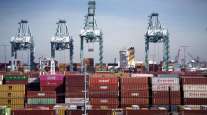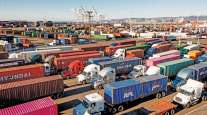Senior Reporter
Nation’s Ports Booming in Anticipation of Holiday Shopping Season

Many of the nation’s ports continue to see growth in import and export activity, as retailers gear up for what is expected to be a strong fourth quarter and holiday shopping season.
The Port of Los Angeles said on Oct. 15 it processed 801,264 industry-standard 20-foot equivalent units, or TEUs, in September, a 4.9% increase from the same period last year and the busiest September in the port’s 111-year history. Last September, the facility moved 763,784 TEUs.
“Volumes remain strong with shippers importing holiday-season inventories and manufacturers bringing supplies and materials in advance of additional cost impacts from tariffs,” Executive Director Gene Seroka said in a statement to Transport Topics.
The Port of Long Beach reported a 0.1% decrease in volume in September as it processed 701,204 TEUs last month compared with 701,619 for the same period in 2017. However, year to date, Long Beach is 10.7% ahead of 2017’s pace, having processed 8,000,929 TEUs compared with 7,239,758.

Port of Long Beach. (Tim Rue — Bloomberg News)
The Northwest Seaport Alliance, which operates facilities in Seattle and Tacoma, Wash., said its August volume declined 6.9% compared with 2017. The 2018 number was 312,321, down from 337,719. Port officials explained the decline by citing weather issues in Asia that caused vessel delays, which threw off shipping schedules.
The Port of New York and New Jersey reported a 6.5% increase in August volume, moving 4,724,780 units compared with 4,438,026 for the same period in 2017.
The Port of Virginia said September volume is down 7.4% from the same period last year as it moved 221,355 TEUs in 2018 compared with 237,816 in 2017. However, for the first quarter of fiscal 2019, TEU volume is up nearly 3% compared with the year-ago period. Port officials said September’s numbers were suppressed by Hurricane Florence, which caused the port to shut down for 3½ days in the middle of the month.
“We lost 10% of our workdays in September as a result of the storm, and that is a significant amount of time for our vessel traffic to be idled,” Virginia Port Authority CEO John Reinhart said. “The closure was necessary to ensure the safety of our colleagues, facilities, cargo and customers. We were fortunate, especially compared with our neighbors in North Carolina.”
Ports are exceptionally busy, because for items to be processed and inventoried before being sent to stores and e-commerce delivery facilities for the holiday season, they usually must arrive in the United States within the next few weeks.
“In recent years, that peak month has actually been moving forward a little bit, and I think that was an influence again this year. So October may not have been the peak month, and it was August or September,” EDR Group Senior Economist Paul Bingham told TT. “More of the importers tended to bring in goods earlier. There is even some impact these days, the last few years because of occasional capacity constraints at peak season, some importers bringing in goods as early as July.”
Bingham said there also is evidence many shippers have been importing and exporting products ahead of the Trump administration’s tariffs, especially items involving China.
The Port of Savannah processed 375,844 TEUs in August, up 7.9% compared with 348,297 in the same period of 2017. August marked the second-highest volume month since the port began keeping records in 2003. The record was set in July, when 378,767 TEUs were moved.

A crane moves a container to be loaded at the Garden City Terminal at the Port of Savannah. (Georgia Ports Authority)
Georgia Gov. Nathan Deal and port authority officials recently announced a $2.5 billion, 10-year plan to increase the Savannah facility’s capacity from 5.5 million TEUs annually to 8 million.
“We are preparing to redefine the Port of Savannah as not simply the load center for the southeastern U.S., but as the port of choice for major inland markets east of the Mississippi River,” Georgia Port Authority Executive Director Griff Lynch said. In 2017, volume at the port jumped 8.4% compared with 2016 and reached more than 4.2 million TEUs for the first time.
The South Carolina Port Authority said August marked the highest TEU volume in its history, up 16% to 206,541 units compared with 177,728 in 2017. The Charleston facility has handled more than 200,000 units for three consecutive months.
“Fall is traditionally a strong season for the port,” CEO Jim Newsome said. “A record-breaking August, and the sixth consecutive record-setting month for container volumes, the port is well-positioned for continued growth through 2018.”
Farther down the Atlantic coast, the Jacksonville Port Authority also had its highest-ever monthly container volume in August. The facility moved 115,700 TEUs, a 17.3% increase over 98,598 a year ago. Officials said the port is on a pace to exceed last fiscal year’s record of 1.3 million TEUs once the final numbers for September are included, now that the 12-month period ended Sept. 30.




